Utah Outdoor Adventures | The Ultimate Outdoor Playground
Utah is a state with a wealth of outdoor recreation opportunities. This is a guide for those of you who have been searching for the best Utah outdoor adventures to take your family. From hiking and backpacking to mountain biking and ATV/offroad/jeep tours, you’ll find what you’re looking for here.
With so many options available for outdoor recreation, Utah is sure to keep even the most experienced outdoor enthusiast on their toes. Whether you’re looking for a peaceful hike in the mountains or a thrilling adventure on the rivers, Utah is the ultimate outdoor playground.
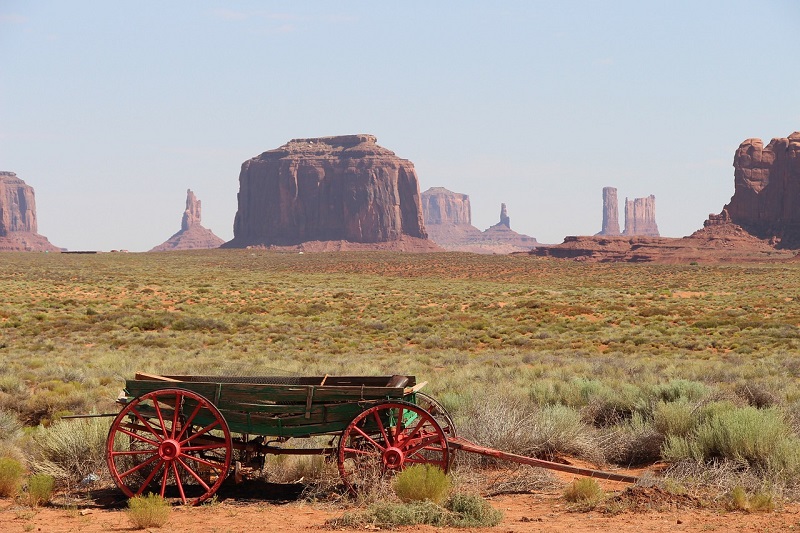
Hike to Delicate Arch in Arches National Park
Delicate Arch, located in Arches National Park, beckons hikers from near and far. 💼 Taking the 3-mile hiking trail to the arch is a challenging journey, but the incredible view at the end is worth the effort. Spectacular sunsets can be seen from the arch, making the trip even more memorable.
Delicate Arch – Utah Outdoor Adventures
The Delicate Arch is one of the most iconic and breathtaking sights in Arches National Park. Located atop a rock formation in the center of the park, this arch stands 60 feet tall and is a remarkable testament to the park’s stunning landscapes. To get the best view of the arch, it is recommended to take the hiking trail that starts at Wolfe Ranch and leads to the arch.
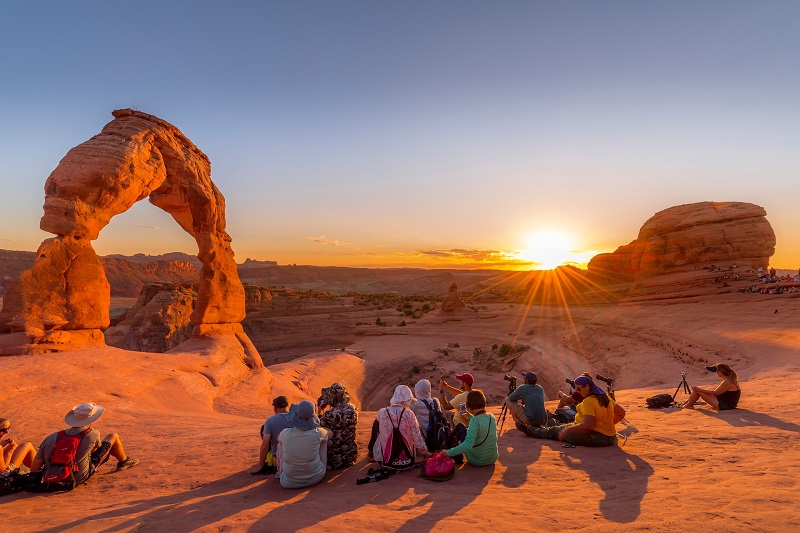
The trail is about 3 miles long and is considered to be of moderate difficulty. Along the way, visitors will be able to take in the scenery and enjoy the views of the park’s other remarkable features. While the trail is open year-round, it is best to attempt the hike during the cooler months as temperatures can reach dangerous levels during the summer months.
At the end of the trail, the view of the Delicate Arch is nothing short of spectacular. The arch stands tall, surrounded by the red rocks of the park and the stunning backdrop of the La Sal Mountains. The view of the arch is best seen at sunset when the colors of the sky and the rocks blend together in a beautiful array of colors.
The Delicate Arch is an iconic sight in Arches National Park and it is an experience that should not be missed. The hike to the arch is an enjoyable one that will reward visitors with a stunning view of the arch and a memorable experience that will last a lifetime.
Arches National Park
The Arches National Park offers a truly unforgettable experience. Located in the rugged landscape of southeast Utah, the park boasts over 2,000 natural sandstone arches, making it a popular tourist destination.
The park’s landscape is truly remarkable, a remarkable feat of nature created over thousands of years of erosion and weathering. The park’s red-orange rock formations come alive in the late afternoon sun, offering a kaleidoscopic display of colors. The park’s canyons, fins, and towers, along with its signature arches, are a photographer’s dream.
The park also offers a variety of activities for visitors, including hiking, camping, and backpacking. For those looking to explore the park, there are over 300 miles of trails to choose from. The most popular trail is the Delicate Arch Trail, which takes visitors to the iconic arch, located atop a large sandstone fin. The trail is three miles roundtrip and is considered to be moderately strenuous.
The park is home to a variety of wildlife, including many endangered species. Visitors may spot bighorn sheep, coyotes, and even mountain lions. As with any park, it is important to be aware of your surroundings and to stay on designated trails for safety.
Arches National Park is an awe-inspiring place that is sure to leave visitors with lasting memories. From its remarkable sandstone arches to its diverse wildlife, it is an outdoor paradise for nature lovers. A visit to the park is sure to be a memorable one.
Hiking Trail
The hiking trail starts at the Wolfe Ranch parking area, where visitors will need to walk an additional half-mile to reach the beginning of the trail. The trail is very easy to follow, and is mostly a mix of dirt and sand, taking the hiker up a steep incline. Along the way, the trail offers a stunning landscape of immense red and orange sandstone formations, making the hike even more enjoyable.
The hiking trail requires a bit of physical activity, as it is about three miles in total, but the views along the way make the journey more than worth it. Every hiker should keep in mind that the trail is an incline, leading up to the peak of the arch. The hike can take anywhere from two to three hours, depending on the hiker’s physical abilities and how often they choose to stop and take in the views.
The hiking trail leads to the Delicate Arch Viewpoint, where hikers can take in the spectacular view of the arch at its peak. From this viewpoint, hikers can also take in the vast landscape of the entire Arches National Park. It is a truly unforgettable experience that should not be missed.
Visit Monument Valley Navajo Tribal Park
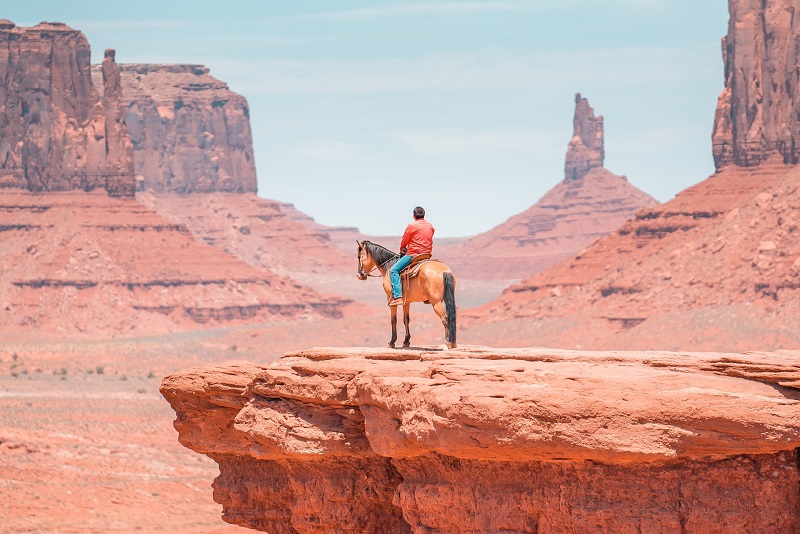
Monument Valley boldly traverses the silent red rocks, offering a breathtaking glimpse of the mesmerizing landscape. Wild Horse Viewing is a unique experience, as visitors patiently wait for the opportunity to witness these majestic animals in the wild. Lastly, exploring the ancient Petroglyphs scattered throughout the park provides invaluable insight into the storied past of the Navajo people.
Monument Valley is a must-see for all visitors to the area. It is home to iconic red-rock formations, and the area offers visitors an opportunity to experience the timeless traditions of the Navajo people.
Monument Valley Tours offers guests a chance to explore the area and its history. The tours take guests on a journey through majestic rock formations, such as the iconic Mittens, Merrick Butte, and Totem Pole. Guests will get to learn about the culture and traditions of the Navajo people, as well as the geology and history of the area. The tour guides are highly knowledgeable and experienced, and they provide insight into the area’s past and present.
The majestic beauty of the landscape is breathtaking, and visitors can take in the stunning views from the comfort of a vehicle. The tours provide an opportunity to get up close and personal with the landscape. Guests can observe the remarkable rock formations, as well as soak in the beautiful desert views as they drive along the sandstone mesas. The experience is truly one-of-a-kind, and no two tours are ever the same.
Monument Valley Tours also provides the chance to appreciate the beauty of the area without the worry of getting lost. The tour guides are familiar with the trails, and they make sure that visitors get the most out of their experience. With their help, visitors can gain a greater appreciation and understanding of the area’s unique history and culture.
Wild Horse Viewing
Wild Horse Viewing is an activity that should not be missed when visiting this stunning region. Monument Valley provides the perfect opportunity to witness these beautiful, wild horses roaming the plains.
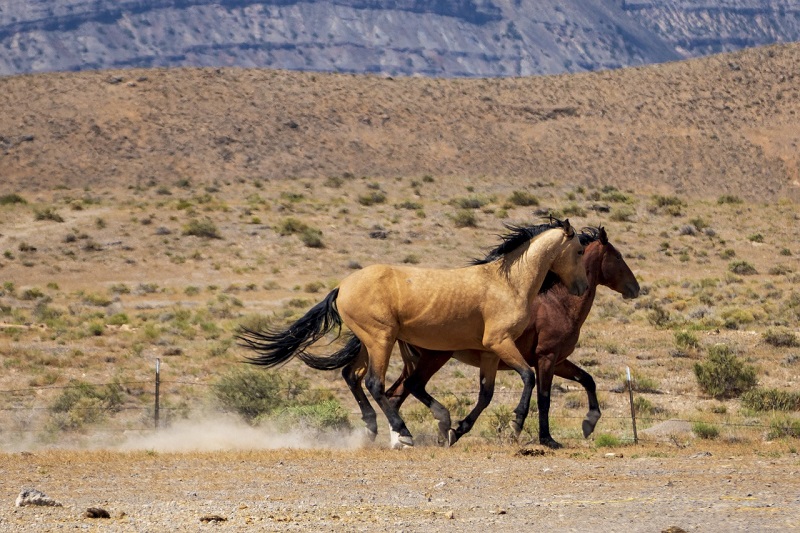
The horses that inhabit this land are an integral part of the Navajo culture and can be seen throughout the area. They are the descendants of horses brought by Spanish settlers centuries ago and have since adapted to the harsh desert environment. On a tour, visitors have the opportunity to observe these animals in their natural habitat, as the tour guides provide knowledge and insight into their behavior.
The horses can be seen grazing and socializing, with their manes blowing in the wind. The sight of these majestic creatures galloping across the desert is a spectacle that can be appreciated by even the most experienced traveler. It is a reminder of the beauty and wildness of nature and a unique experience that cannot be found anywhere else in the world.
The Monument Valley Tours provide visitors with the opportunity to learn about the history and culture of the horses and to appreciate the beauty of the land. It is an unforgettable experience and one that is sure to be remembered for years to come.
Petroglyphs
The journey now continues to Monument Valley Navajo Tribal Park. This sprawling landscape of red mesas and buttes is rich in history and culture, offering visitors the chance to discover the many attractions the park has to offer. Among the most captivating activities are the petroglyphs, which are a unique and meaningful way to explore the region.
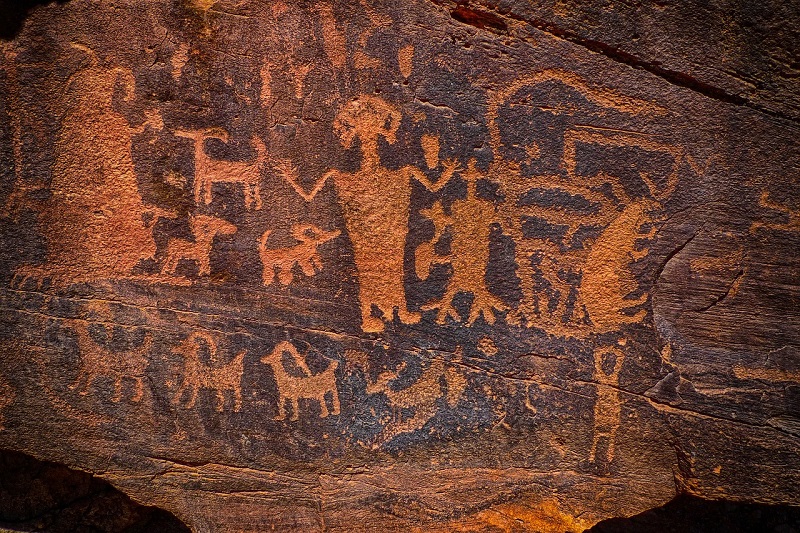
These ancient symbols, carved into the rock walls by the native people, are thought to have been created between 500 and 2000 years ago. Petroglyphs tell of the lives of the people who lived in the area at the time, from stories of hunting and gathering to the creation of gods and spiritual beliefs. The symbols can be found all along the valley walls, from the banks of the San Juan River to the base of the mesas.
The petroglyphs have been carefully preserved by the Navajo people, who are the stewards of the land and still actively practice their traditional beliefs. On a guided tour, visitors can learn more about the stories that are told in the petroglyphs from Navajo tour guides, who are deeply knowledgeable about their culture and history.
The petroglyphs of Monument Valley Navajo Tribal Park are a powerful reminder of the people who lived in this area centuries ago. They offer a glimpse into the lives of the past, providing visitors with a unique opportunity to connect with the land and its history. Italicizing these ancient symbols is a way to show respect and honor the people who lived here before, and to appreciate the beauty of the land that remains today.
Rafting on the Colorado River – Utah Outdoor Adventures
The Colorado River through Cataract Canyon is an unforgettable experience for rafters of any skill level. Rafting 101 will prepare adventurers with the basics of maneuvering a boat, such as rowing, steering, and different rescue techniques. Safety Precautions must be taken to ensure the best possible experience, such as acquiring the proper gear and being aware of the surrounding area. Participants will explore the Canyons and Rapids of the Colorado River, taking in the breathtaking scenery and thrills of the rapids as they navigate the canyon.
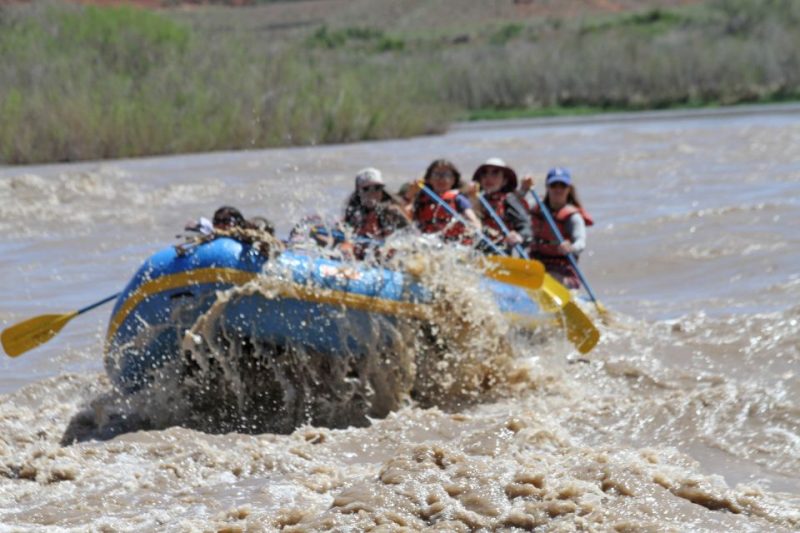
For the adventurous traveler, there is no better way to experience the canyon’s majesty than from the rolling waves of the Colorado River. Rafting Colorado is a unique and exciting way to explore the canyon’s depths and experience all that Cataract Canyon has to offer.
Rafting is a great way to explore the river, as it allows for a hands-on experience and unrestricted access to the canyon’s many features. For those interested in rafting, there are a variety of options available. From calm stretches of flatwater to thrilling whitewater rapids, the Colorado River offers something for everyone.
Before beginning the journey, it is important for all rafters to understand the basics of the sport. Rafts, which can vary in size and capacity, are the primary means of navigating the Colorado. Inflatable rafts come in two different types: paddle rafts, which are propelled by a group of paddlers, and oar rafts, which are guided by a professional oarsman. It is important to select the right size raft for the group, as well as the right type of raft for the desired experience.
Rafts are typically equipped with a variety of safety gear, including life jackets, oars, and throw bags. Knowing how to use this equipment is essential for navigating the canyons safely. It is also important to become familiar with the river and its features before embarking on a rafting journey. Understanding the river’s flow, rapids, and hazards will help ensure a safe and enjoyable experience.
Rafting the Colorado River through Cataract Canyon is an exhilarating adventure and a great way to experience the canyon’s beauty. With a little preparation and knowledge, rafters can have a safe and enjoyable journey down the river.
Safety Precautions
In order to stay safe while rafting, it is important to take the necessary safety precautions. Wearing a personal flotation device (PFD) is essential when rafting. PFDs provide additional buoyancy and can help prevent drowning should a person fall out of the raft. It is also important to wear a helmet, which can help protect the head from impacts with rocks or other objects in the river. Lastly, it is important to understand the river and be aware of potential hazards. It is important to take into account the size and speed of the rapids, as well as the depth and temperature of the water.
It is also important to have a knowledgeable and experienced guide on the trip. The guide should be familiar with the river and its safety hazards and should be able to provide instruction and guidance on how to navigate the rapids. The guide should also be able to provide assistance in the event of an emergency.
Lastly, it is important to ensure that all the necessary equipment is in the raft. This includes paddles, throw ropes, life jackets, and a first-aid kit. It is also important to bring along extra supplies and food in case of an emergency.
Canyons and Rapids
A trip down the canyon will take rafters through a series of awe-inspiring canyons and rapids, providing them with a truly unique experience.
The canyons and rapids of Cataract Canyon are some of the most majestic and powerful in the American Southwest. Ideal for experienced rafters, the canyon walls tower thousands of feet above the river, and the rapids can range from class II to class V, depending on the water level. From the thunderous roar of the rapids to the peaceful solitude of the canyons, rafters will be provided with a combination of sensations that make this journey unforgettable.
As the Colorado River winds through Cataract Canyon, rafters will have the opportunity to take in the breathtaking beauty of the canyon walls. These walls are comprised of thick layers of sandstone, offering varying shades and textures that contrast with the deep blue of the river. Along the journey, stunning natural features such as arches, potholes, and waterfalls can be seen in the canyon walls, providing a unique view of the landscape.
The rapids of Cataract Canyon are especially impressive, providing rafters with an adrenaline rush as they take on the whitewater. As the river churns and boils around them, rafters will feel the power of the Colorado River as they navigate the rapids. Experienced guides will be on hand to ensure that rafters remain safe and have a thrilling adventure.
From the majestic canyons to the thrilling rapids, a journey down Cataract Canyon promises to be an unforgettable experience. For the daring and adventurous, a trip through Cataract Canyon is guaranteed to provide memories that will last a lifetime.
Hike the Narrows in Zion National Park
After experiencing the adrenaline rush of rafting down the Colorado River through Cataract Canyon, why not take on the challenge of hiking the Narrows in Zion National Park? Exploring The Narrows in Zion National Park is an exciting adventure – one that requires proper planning and preparation. To ensure a safe and successful journey, hikers should be aware of the hiking requirements and the appropriate gear guide. Additionally, hikers must be familiar with the trail map to plan their route throughout the park.
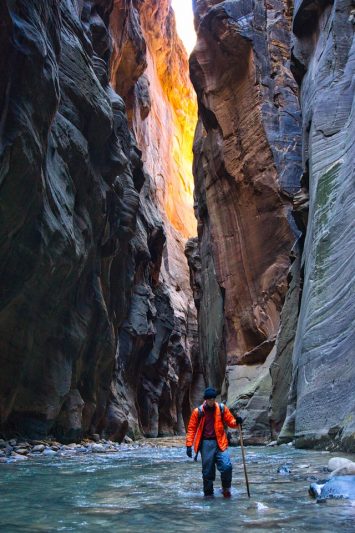
Hiking Requirements
It is a must-do for any outdoor enthusiast. Hiking the Narrows comes with some unique requirements that must be taken into account before setting out on the trail.
A permit is required for hiking the Narrows, and these are issued on a first-come, first-serve basis. Permits can be acquired ahead of time in the spring and summer months. Those who plan to hike in the fall or winter, when the weather is colder and the water levels are higher, may need a backcountry permit. It is advisable to check with the park rangers to see which type of permit is necessary for the time of year.
Another requirement for hiking the Narrows is that visitors should be prepared for a wet hike. The majority of the trail is through the Virgin River, so visitors should come equipped with the proper clothing and gear. Wetsuits, river shoes, and walking sticks are essential for a safe and enjoyable experience. In order to avoid the park’s high temperatures, it is also recommended to begin hiking early in the morning.
Finally, it is recommended to bring a map of the trail. While the trail is relatively straightforward, the map can help hikers stay on the right track and identify points of interest. The map can also provide useful reminders for how to stay safe while in the park.
Hiking the Narrows is an unforgettable experience for any outdoor enthusiast. By taking the necessary precautions, hikers can ensure a safe and enjoyable journey.
Gear Guide
Having conquered the rapids of Cataract Canyon, adventurers may turn their attention to Zion National Park and the hike of a lifetime through the Narrows. Outfitted with the proper gear, hikers can traverse the spectacular slot canyons and towering sandstone walls of the Virgin River.
The first step to preparing for a hike through the Narrows is to understand the requirements. Wading through the canyon necessitates that hikers wear waterproof, breathable waders, or waterproof trousers. Additionally, hiking poles are highly recommended for stability and to support the weight of a backpack. Lastly, the Narrows is in a desert environment and contain no potable water, so hikers must bring their own water supply.
Once the necessary requirements are in place, adventurers can turn their attention to the proper gear for the hike. Comfort and safety are of the utmost importance, so sturdy, waterproof, and breathable boots or shoes are essential. To keep the feet dry, a pair of gaiters should also be considered. A small backpack is also essential, as it should contain snacks, a camera, and a waterproof map.
Next, it is important to consider the clothing and accessories that will be needed for the hike. If necessary, a rain jacket should be packed in the event of sudden showers. Depending on the season, a light or heavy coat is also recommended. To keep the sun from damaging the skin, a wide-brimmed hat, long sleeves, and sunscreen are also essential. A small first-aid kit should be included in the backpack, as should a flashlight and a compass.
The Narrows is a hike to remember for a lifetime. Outfitted with the right gear and understanding the necessary requirements, adventurers can traverse the stunning slot canyons of Zion National Park in comfort and safety.
The Trail Map
For those looking to traverse the trail, it is essential to be aware of the terrain and the trail map to ensure a safe and enjoyable hike. The trail begins at the Temple of Sinawava, which is easily accessible by the Zion Shuttle. From there, hikers can begin their journey through the Virgin River. The river runs through the canyon, and the trail follows its winding path. As the canyon narrows, trekkers will be immersed in towering walls that reach heights of up to 1,000 feet. The canyon walls are filled with deep purple and red hues, creating an incredible landscape. The entire path is 16 miles long, with the first 8 miles of the trail considered the “Narrows”, and the last 8 miles considered the “Narrows Extension”. Along the way, hikers will be presented with several side trails that offer a variety of geological wonders, such as Emerald Pools, Weeping Rock, and Big Springs. It is important to be aware of the different junctions and to take note of the various landmarks, as these will help navigate the trail.
Additionally, it is important to keep in mind the various terrains of the trail. The terrain ranges from sandy patches to shallow pools, to rocky surfaces. With the changing terrain, it is essential to make sure to wear water-friendly shoes and socks, as some parts of the trail require trekkers to wade in the water. Furthermore, hikers should be aware that the Narrows is a one-way trip. Thus, if they choose to continue on the Narrows Extension, they will need to make arrangements for transportation back to the Temple of Sinawava.
The Narrows trail is a beautiful journey that offers a unique view of Zion National Park. With the help of the trail map, hikers can make the most of the journey and experience the stunning canyon walls.
Mountain Biking in Moab
Exploring Moab‘s trails on a mountain bike offers an unparalleled experience, with terrain ranging from easygoing desert paths to challenging rocky hills. From the basics of mountain biking to tips on navigating the trails, and even arranging bike rentals, a visit to Moab is sure to be an unforgettable adventure.
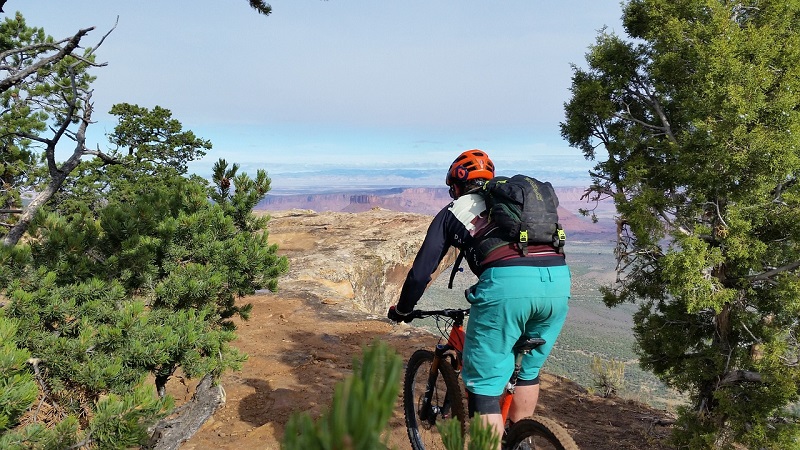
Moab Trails – Utah Outdoor Adventures
Leaving the Narrows behind, adventurers are presented with the opportunity to explore the desert trails of Moab, Utah. Gliding through the sun-drenched landscape, Moab is a biking haven for all levels of riders. From technical trails with tight turns and steep drops to rolling paths perfect for a leisurely ride, Moab trails offer something for everyone.
Navigating the terrain, riders should familiarize themselves with the various trails Moab has to offer. Many of the trails are located in the popular Dead Horse Point State Park, which features miles of trails with both flat and hilly terrain. Trails like Captain Ahab, Porcupine Rim, and Sovereign are the most popular, offering distinct terrain and views. The magnificence of the red rock desert and the Colorado River can be seen from many of the trails, providing a true adventure.
For those wanting a more technical experience, the Mag 7 trails offer a plethora of technical obstacles to challenge any rider. From rock drops to tight turns, the Mag 7 trails will test any rider’s skills. A little further away, riders can find Kryptonite, an expert-level trail that will challenge even the most experienced riders.
No matter what type of rider, Moab has trails to accommodate. With so many trails and views, it is easy to see why Moab is considered a must-ride destination for all mountain bikers.
Mountain Biking Tips
Swapping hiking boots for wheels, a mountain biking journey awaits in Moab. With slick rock trails carved into the red desert landscape, Moab offers the perfect backdrop for a thrilling ride. To ensure an enjoyable and safe experience, here are some mountain biking tips to keep in mind.
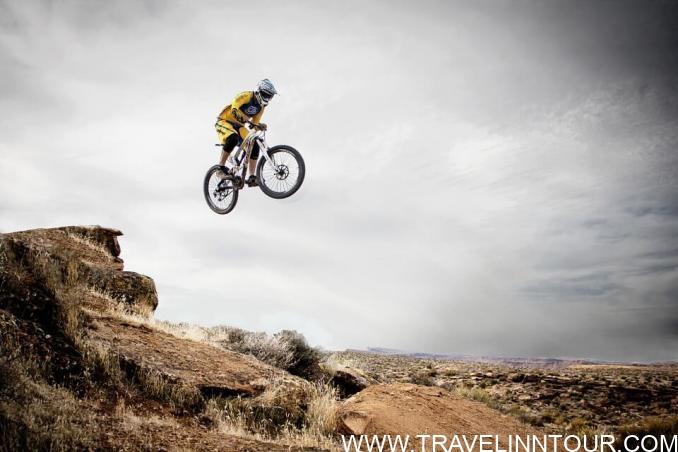
Braking is essential for a smooth and safe ride. Knowing when and how to brake is important for navigating tight turns and maintaining control on challenging terrain. Applying the rear brake will give riders more control and help keep the front wheel from skidding. Conversely, applying the front brake will slow the bike down faster, but comes with the risk of skidding if applied too hard.
Shifting Gears is another important component of mountain biking. Shifting gears helps riders maintain a steady and comfortable pace, while also conserving energy for more difficult sections of the trail. Beginners should focus on finding the right gear for the terrain, while experienced riders can use shifting to fine-tune their speed.
When riding on technical terrain, body positioning is key. The rider should be in a slightly crouched position with the elbows slightly bent. This position allows the rider to remain centered and keep the bike balanced. Additionally, maintaining an upright posture will help riders stay aware of their surroundings.
Following these tips will help create a more enjoyable and safe mountain biking experience in Moab.
Bike Rentals
Those who take the challenge will be rewarded with an incredible experience that is only amplified by the surrounding scenery. Bike rentals should be the first step in making the journey happen.
Rentals in the area are plentiful, and available at a variety of prices depending on the type of bike, the length of rental, and other factors. Most shops will have a selection of mountain bikes, which are well-suited for the region. These bikes are designed for off-road riding, with a range of features such as suspension, wide tires, and powerful brakes. Some shops may also offer electric bikes, which provide an extra boost of power from a battery-powered motor.
In addition to the rental fees, many shops also require a damage deposit, which varies depending on the bike and the length of the rental. Before renting, it is important to ask questions about the condition of the bike, as well as the rules and regulations of the shop. This is especially important in Moab, as the terrain can be challenging and the trails can be hazardous.
For those looking for an adventure in Moab, bike rentals are a great way to get started. With a few inquiries and the right paperwork, riders will be on their way to an unforgettable experience.
Stargazing in the Great Salt Lake Desert – Utah Outdoor Adventures
Spanning the night sky, the Great Salt Lake Desert presents an awe-inspiring landscape for stargazing. During the dark skies, the moon phases alter the character of the stars, providing a unique experience. Meanwhile, the constellations offer a chance to explore an unknown world.
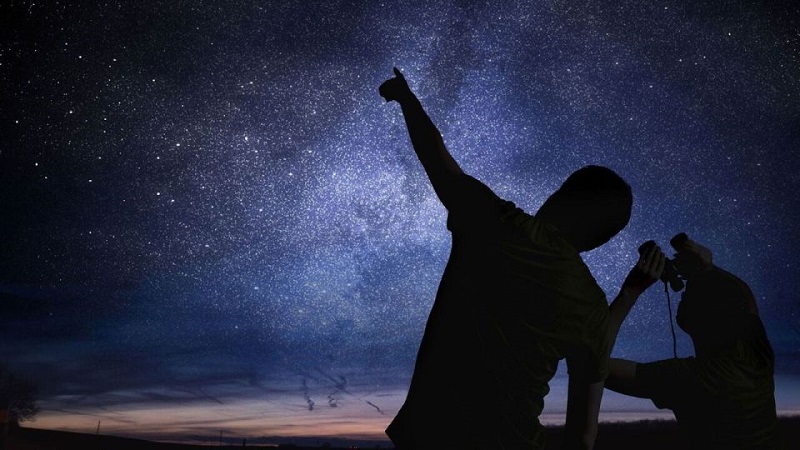
Dark Skies
Lingering in the wake of the dusty mountain biking trails in Moab, the next destination is an immersive stargazing experience in the Great Salt Lake Desert. Dark Skies here provide an unparalleled experience for amateur and experienced astronomers alike.
The night sky in the Great Salt Lake Desert is an absolute spectacle to behold. Its vastness, illuminated by starry constellations and galaxies, is an awe-inspiring sight. The dark skies here are the perfect canvas for stargazers, offering clarity and brightness that is difficult to find in cities and other highly populated areas. The stars here shine brightly, standing out from the night sky in a way that is difficult to describe.
The area is known for its unparalleled dark skies, but the experience here is more than just a show of stars. Stargazers here can also witness the moon phases, where the moon changes in size and shape over the course of the month. From the full moon to the crescent, the moon can be seen in its various stages of luminescence and can offer a great opportunity for taking pictures and learning about the lunar cycle.
The Great Salt Lake Desert is the perfect place for an unforgettable stargazing experience. With its unparalleled dark skies and its ability to show the moon in its various phases, the area provides an unforgettable experience for those who are looking for a night of exploration and wonder.
Moon Phases
After a long day of mountain biking in Moab, the night sky over the Great Salt Lake Desert can offer a beautiful and serene stargazing experience. The desert is renowned for its dark skies, illuminated by the moon in its various phases.
The moon has eight primary phases in a lunar cycle, each one lasting approximately three and a half days. The first phase is the New Moon, which is the least visible phase as the moon is between the Earth and the sun. The New Moon is the darkest night of the lunar cycle and a great time to observe stars, galaxies, and constellations.
As the moon moves around the earth, its phase changes gradually and is visible as a Waxing Crescent. The Waxing Crescent is the first phase that is visible in the night sky when the moon is lit on the right side. This is followed by the First Quarter phase when the moon is lit on the top right side. As the Waxing Moon continues its cycle, it becomes a Gibbous Moon, with more than half of the lunar surface visible, and then a Full Moon, when the entire moon is lit up.
The Full Moon is the brightest night of the lunar cycle and is a great time to observe the shadows of the moon’s craters and other features. After the Full Moon, the phase changes to the Waning Moon, with the Last Quarter and Waning Crescent phases following in that order. As the moon continues to orbit the Earth, it becomes the New Moon once again, completing the lunar cycle.
The moon‘s phases offer a unique opportunity to observe the night sky in different moods and lighting conditions. Stargazing in the Great Salt Lake Desert provides an unforgettable experience as the moon’s phases illuminate the dark sky.
Constellations – Utah Outdoor Adventures
Having left the majestic red rocks of Moab behind and embarked on an unforgettable journey to explore the Great Salt Lake Desert, we now find ourselves beneath a canopy of stars. As the night deepens, we can experience the wonders of the dark skies, marvel at the changing phases of the moon, and take in the beauty of the constellations.

When looking up at the night sky, we can observe the constellations, which are groups of stars that create patterns or shapes in the sky. The constellations appear like images in the sky, and they can be used to tell stories, guide travelers, and connect us to mythology, literature, and cultures from around the world. These star patterns have been part of human culture for thousands of years, and they’re still a source of wonder and fascination today.
The constellations are often named after figures from mythology and ancient stories, such as Aries, who is a ram from Greek mythology; Orion, who is a hunter from Greek mythology; and Cassiopeia, who is a queen from Greek mythology. Every culture has its own set of constellations, and even today, astronomers are discovering new star formations and giving them names.
In addition to being a source of beauty and mystery, constellations can also help us find our way in the night sky. By learning the patterns of the stars, we can use them to navigate and orient ourselves in the dark. This can be especially helpful when we’re in unfamiliar places and need to find our way back to camp.
So, the next time you’re out in the desert, take a moment to look up at the night sky and marvel at the beauty of the constellations. Whether you’re trying to locate a star formation or just gazing up in wonder, you’re sure to be captivated by the mysterious night sky.
Visit the Bonneville Salt Flats – Utah Outdoor Adventures
The Bonneville Salt Flats have a rich history, dating back to the days of the first pioneers of the West. The Flats are a wildlife haven, populated by a wide variety of birds, mammals, and reptiles. The Visitor Center is the perfect spot to begin your exploration of this unique and magical landscape.
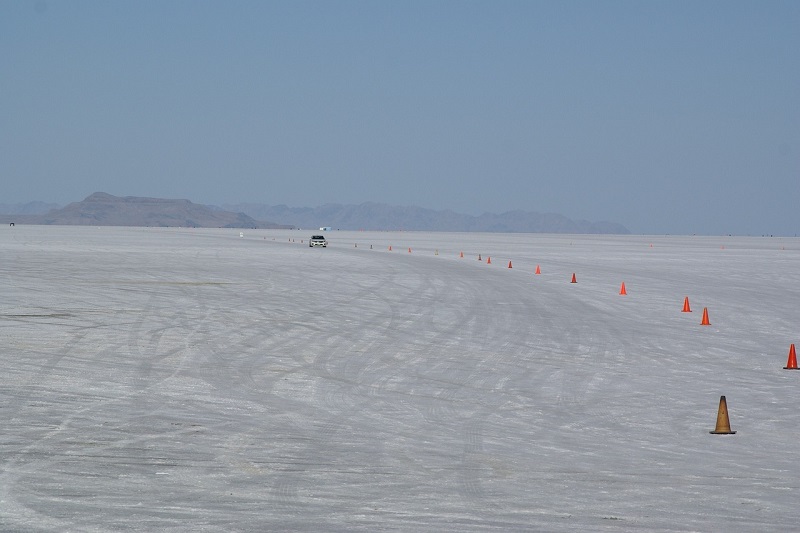
History
Bonneville Salt Flats is a region of the Great Salt Lake Desert and is renowned for its flatness and salt crust. It has a long and varied history, from the ancient Native Americans to the U.S. Army Corps of Engineers. The area was originally part of the ancient Lake Bonneville, which covered much of western Utah during the Pleistocene Epoch. After the lake evaporated, the area was transformed into a salt flat, with its surface composed of salt crust.
The area has been an important part of the local history since the 19th century when it began to be used as a crossing point for the Oregon Trail. It later became a popular destination for automobile and land speed records, beginning in the 1930s. In the 1950s, the U.S. Army Corps of Engineers began building a causeway across the flats, which is still in use today.
The Bonneville Salt Flats are a remarkable example of the power of nature, and provide a unique glimpse into the area’s past. The site is now a National Historic Landmark and remains a popular destination for visitors. The area is also home to diverse wildlife, including migratory birds, coyotes, and a variety of small mammals. Visitors can explore the area on foot, or take a guided tour of the flats to learn more about its history and unique features.
Wildlife
Stepping away from the awe-inspiring night sky, the Bonneville Salt Flats offer a unique and diverse wildlife experience. Spanning over 30,000 acres of the Great Salt Lake Desert, the Bonneville Salt Flats is home to a variety of animals.
The salt flat is a great place to spot scenic birds like the American White Pelican, Long-billed Curlew, and Great Egret. A variety of shorebirds, ducks, and waterfowl can also be spotted in the area. In the spring and summer, the salt flat is teeming with waterfowl and shorebirds.
The salt flat is also home to a number of small mammals including the Desert Cottontail, Coyote, Bobcat, and Kit Fox. It is also a great place to spot reptiles like the Desert Tortoise, Gopher Snake, and Common Side-blotched Lizard.
The Bonneville Salt Flats also has a rich history and offers a number of educational opportunities. The Visitor Center provides a variety of interpretive programs and guided tours of the area. The center also houses a number of exhibits on the history, wildlife, and geology of the salt flat.
Bonneville Speedway – Utah Outdoor Adventures
The Bonneville Salt Flats are a vast, flat expanse of salt located in northwestern Utah. They are a remnant of Pleistocene Lake Bonneville, which once covered much of the Great Basin. The salt flats are known for their flatness and smoothness, which make them ideal for land-speed racing.
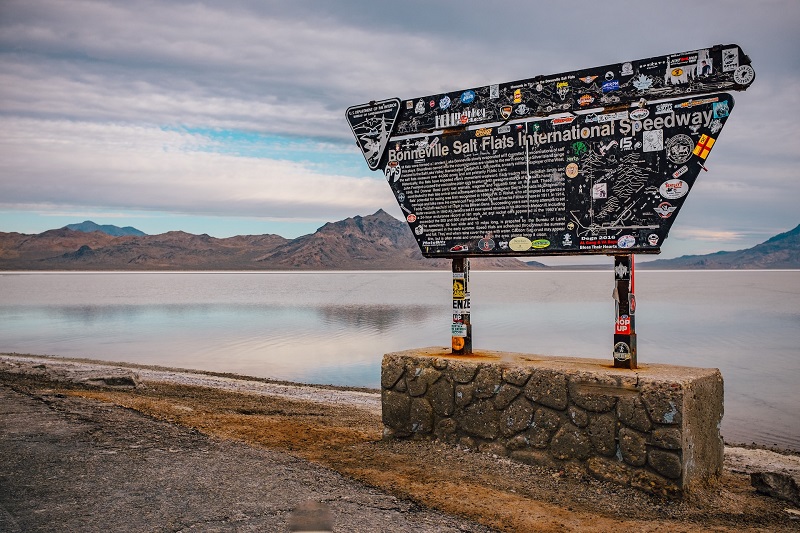
Bonneville Speedway is a 10-mile (16 km) long straightaway on the Bonneville Salt Flats. It is the site of many land speed records, including the current world record of 763.035 mph (1,227.985 km/h) set by Craig Breedlove in 1964. The speedway is also used for other events, such as car shows, motorcycle rallies, and hot air balloon races.
Visitors can drive on the salt flats, take guided tours, or watch land speed races. The flats are also a popular place for photographers and artists.
Here are some things you can do at Bonneville Speedway:
- Drive on the salt flats: Visitors are allowed to drive on the salt flats, but they must be careful to stay on the marked paths. The salt can be very slippery, and it is important to drive slowly.
- Take a guided tour: There are several companies that offer guided tours of the Bonneville Salt Flats. These tours can teach you about the history of the flats and the land speed records that have been set there.
- Watch land speed races: The Bonneville Salt Flats host several land speed races each year. These races are a great opportunity to see some of the fastest cars and motorcycles in the world.
- Take photos: The Bonneville Salt Flats are a beautiful place to take photos. The vast expanse of salt is a great backdrop for photos of cars, motorcycles, and landscapes.
- Paint or draw: The Bonneville Salt Flats are also a popular place for artists. The smooth, flat surface of the salt is a great canvas for painting or drawing.
Skiing or Snowboarding at Park City Mountain Resort
The renowned Park City Mountain Resort offers an array of lift tickets to suit every skier or snowboarder’s needs. With over 300 runs, suitable for all levels of experience, and state-of-the-art ski school facilities, Park City is the perfect destination for an unforgettable ski holiday.
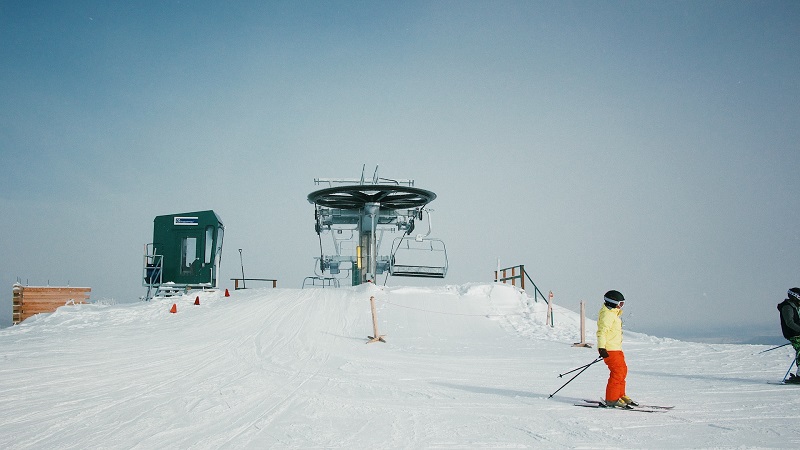
Lift Tickets
After exploring the vastness of the Bonneville Salt Flats, the thrill of skiing and snowboarding at Park City Mountain Resort is calling. With its large selection of lift tickets, runs, and ski school, Park City Mountain Resort is the perfect place to take a winter vacation.
Lift tickets come in a variety of prices, making it easy for visitors to find one that fits their budget. For those looking to ski or snowboard for the entire day, an all-day lift ticket is available. For those who are only able to ski or snowboard for a few hours, an afternoon lift ticket is the perfect option. Park City Mountain Resort also offers multi-day lift tickets for those who are looking to stay longer. The resort even offers discounted lift tickets for those who purchase in advance or for groups.
For those looking for a thrill, Park City Mountain Resort offers a variety of runs. From its thirty-five terrain parks and bowls to its groomed slopes and tree-lined runs, the resort has something for every skill level. Beginner skiers and snowboarders can find solace in the resort’s green circles, while intermediate skiers and snowboarders can challenge themselves with its blue squares. For advanced skiers and snowboarders, the resort offers its black diamonds. Park City Mountain Resort is also home to the world-famous, Eagle Superpipe, which is the ideal destination for those looking to master their halfpipe tricks.
For those who are new to skiing or snowboarding, the resort offers ski school. The resort’s ski school offers private and group lessons for skiers and snowboarders of all skill levels. Private lessons provide the opportunity to receive tailored instruction from an experienced instructor. Group lessons provide the opportunity to learn with others of a similar skill level. Park City Mountain Resort’s ski school teaches the fundamentals of skiing and snowboarding while helping visitors to improve their technique.
Park City Mountain Resort is the perfect winter destination for those looking to ski or snowboard. With its large selection of lift tickets, runs, and ski school, Park City Mountain Resort is sure to provide a memorable winter experience.
Runs
At Park City Mountain Resort, the variety of runs is unparalleled. Intermediate and expert skiers alike will find the runs a challenge, as they weave around trees and traverse down the mountain. For those just starting out, there are plenty of groomed runs to get comfortable with the sport. For more adventurous skiers, Park City Mountain Resort offers numerous double black diamond runs. Though these runs are intimidating, the rewards that come with conquering them are immense.
Visitors can also find runs that offer spectacular views. From the top of the mountain, skiers can look out over the valley and take in the full splendor of the Wasatch Mountains. Additionally, Park City Mountain Resort offers backcountry access that allows visitors to explore the terrain beyond the resort.
The array of runs at Park City Mountain Resort will leave skiers and snowboarders of any level feeling satisfied. Whether seeking a challenge or taking it easy, the resort offers something for everyone.
Ski School
Here, visitors can learn the basics or sharpen their skills with Ski School. The Ski School at Park City Mountain Resort offers a variety of lessons that cater to all levels of skiers. Beginner skiers can take advantage of the 3-day progression program, which includes three full days of instruction and lift tickets, as well as the one-day Newcomer Pass. This pass includes lift tickets and a full-day lesson designed to teach fundamental skiing techniques, such as turning and stopping.
For those who are more experienced, Intermediate and Advanced skiers can benefit from private lessons, which are tailored to their skill set. Private lessons are available for half-days or full-days and include lift tickets. Instructors will focus on refining the skier’s technique, as well as introducing new elements and skills.
Finally, Expert skiers can take part in the Park City Mountain Resort Ski and Ride School. This program introduces skiers to the mountain’s steeps, bumps, and trees, and provides them with the tools and techniques needed to ski or ride the slopes with confidence. Instructors, who are all experienced and certified, will provide detailed instruction and personalized feedback to ensure that the skier leaves with a thorough understanding of the terrain.
The Ski School at Park City Mountain Resort offers something for everyone, from beginners to experts, and provides an opportunity to learn the fundamentals or to refine skills in a safe and supportive environment.
Rent a 4×4 Vehicle and Explore Hell’s Revenge Trail
The perfect adventure awaits those who rent a 4×4 vehicle and explore Hell’s Revenge Trail. Preparation for the journey is paramount; directions must be accurately followed and trail highlights should be carefully researched. From the red-rock canyons to the majestic sandstone sculptures, the trail offers an unforgettable experience.
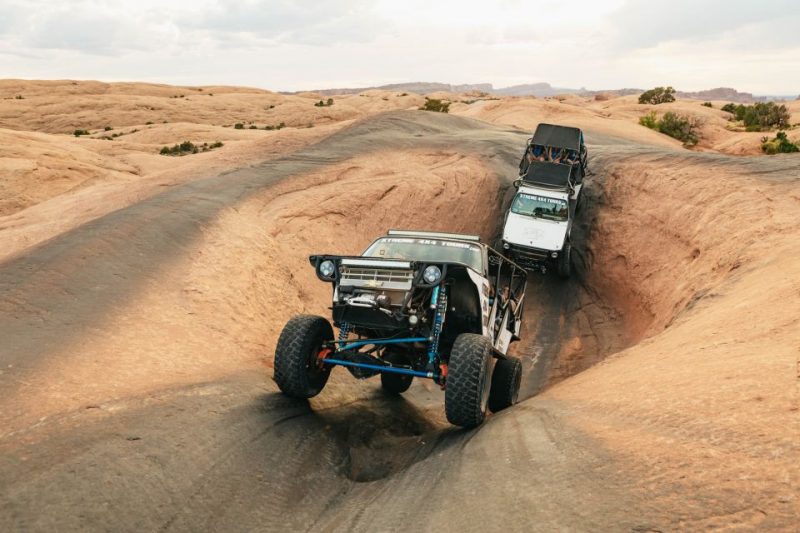
Preparation
One of the most important steps to ensure a safe and successful exploration is to ensure the 4×4 vehicle is in proper working order. An inspection of the tires, brakes, and suspension should be conducted prior to heading out. It is also wise to pack a few spare tires, tools, and other supplies in case of emergency.
Next, an experienced guide should be acquired. This guide will be able to navigate the trails, recommend the best routes, and provide insider tips. Additionally, having a guide will give peace of mind, as the trails can become quite dangerous if proper caution is not taken.
Finally, it is wise to bring multiple sources of communication. A cell phone and a two-way radio should be included, as well as extra batteries. In the unlikely event of an emergency, these items will be critical to ensuring a safe return home.
With the proper preparation, an exciting and unforgettable exploration of Hell’s Revenge Trail is sure to follow.
Directions
Preparation is key for an off-roading trail adventure, so it’s best to rent a 4×4 vehicle and make sure you have all the necessary equipment and supplies.
For anyone looking to explore Hell’s Revenge Trail, the directions are simple to follow. The trailhead is located north of Moab, Utah, off of US 191. To get there, start by taking US 6 east from I-70 and follow it until you reach US 191. Take US 191 north for about 6 miles until you reach the trailhead. It’s important to keep in mind that the trailhead is easily missed, so make sure to look for the signs that mark the entrance.
Once you reach the trailhead, you’ll see the start of the trail. The trail is full of twists and turns, cliffs, and sand pits. It’s about 10 miles long with an elevation gain of 1,500 feet. Make sure to bring plenty of water and snacks, as the trail can take up to 4 hours to complete. It’s best to plan for the entire day, as you’ll likely want to make multiple stops along the way to take in the breathtaking views.
The trail is rated as a moderate difficulty, but it still requires some experience in off-roading. It’s important to take your time and drive safely, as there are many obstacles throughout the trail. It’s also recommended to bring a friend for safety purposes, as well as to take in the views together.
Following these directions will have you on your way to exploring Hell’s Revenge Trail. From the stunning desert views to the off-roading challenges, the trail is an adventure that you won’t soon forget.
Trail Highlights – Utah Outdoor Adventures
To be prepared, it is recommended to bring a spare tire, some extra food and water, and a first-aid kit. It is also important to check the weather before setting out as the terrain can be dangerous in wet conditions.
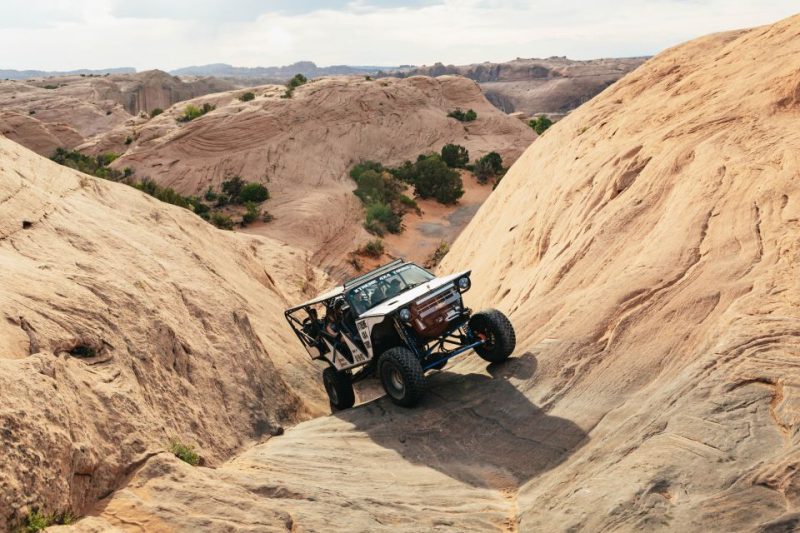
The Hell’s Revenge Trail is an exhilarating off-road experience for the more experienced 4×4 driver. It is located just outside of Moab and is known for its steep and rugged terrain. It is bold approximately 4.5 miles long and offers a bold number of obstacles for drivers to navigate.
Along this trail, you will be able to take in spectacular views of the surrounding mountains and desert. You may even be lucky enough to spot some local wildlife, such as lizards and birds. You will also get to experience the thrill of ascending and descending steep hills and navigating narrow boulders.
At the end of the trail, you will be rewarded with a stunning view of the La Sal Mountains. The view will give you a sense of accomplishment and the feeling of having conquered the trail. With its stunning sights, exciting hills, and challenging obstacles, the Hell’s Revenge Trail is sure to be a memorable adventure.
Rock Climbing in Red Rock Canyon National Conservation Area
The Red Rock Canyon National Conservation Area is an ideal destination for rock climbing, with its sheer cliffs and stunning views. The weather conditions vary depending on the season, from hot summer days to crisp winter mornings. It is important to assess the safety of each climb, taking into account wind, temperature, and other potential hazards. It is also essential to bring the right equipment to ensure a safe and enjoyable climbing experience.
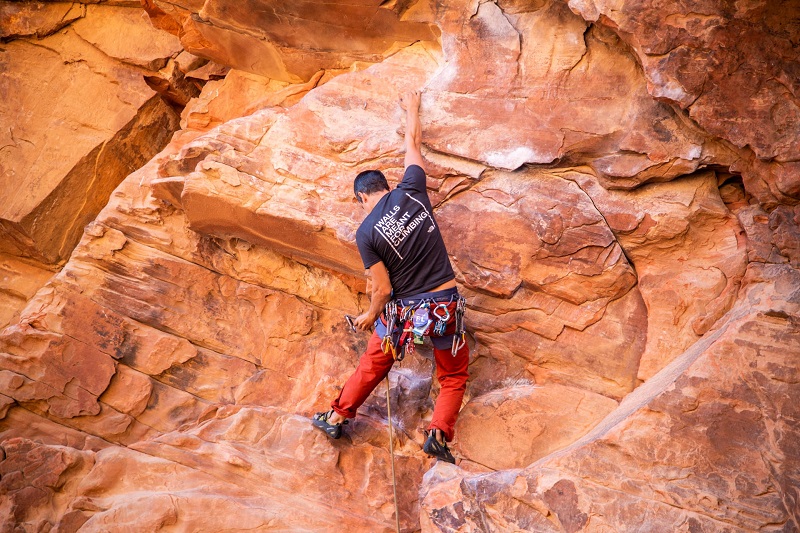
Weather Conditions
After a thrilling adventure off-roading through Hell’s Revenge Trail, it’s time to take on something new. Red Rock Canyon National Conservation Area is the perfect place for outdoor enthusiasts to challenge themselves. From the towering red sandstone cliffs to the winding trails, Red Rock Canyon offers a unique and exciting adventure.
Weather Conditions for Red Rock Canyon can vary greatly depending on the season. During the summer months, temperatures can soar above 100°F and the sun can be relentless. It’s best to plan your climbing trips during the cooler months of the spring and fall. When the temperatures drop, the cliffs become a playground for climbers of all abilities. During the winter, temperatures can drop below freezing and the cliffs become covered in a thin layer of ice, making them even more challenging.
When planning your climbing trip, it’s important to know the conditions of the area before you set off. You should always check the weather forecast before you leave to make sure you are prepared for whatever conditions you may encounter. Even if the forecast is clear, conditions can change quickly in the desert, so it’s important to be aware of your surroundings and the changing conditions.
The key to a successful climbing trip is to be prepared for any situation. Make sure to bring plenty of water, snacks, and layers of clothing so that you can be prepared for whatever the conditions may be. With the proper preparation and an adventurous spirit, you can have an amazing climbing experience in Red Rock Canyon.
Safety
Gaining momentum from the off-road adventure, it’s time to take on the challenge of rock climbing in the Red Rock Canyon National Conservation Area. This area is home to some of the most stunning rock formations in the world, and no outdoor enthusiast can resist the draw of its imposing cliffs and steep canyons. Safety should always be the top priority when engaging in any outdoor activity, and rock climbing is no exception.
The weather conditions at Red Rock Canyon National Conservation Area can vary considerably from day to day. It is important to check the forecast before heading out and to make sure to dress appropriately for the weather. Layering is key, as temperatures can get quite warm during the day before cooling off significantly at night. Having proper gear and clothing on hand to take on any weather condition is critical.
Safety should always be the number one priority when engaging in any outdoor activity, and rock climbing is no exception. Adequate preparation is a must before taking on any climb. It is important to know your limits and not attempt a climb beyond your skill level. Additionally, it is always recommended to climb with a partner or group, as this adds an extra layer of safety. It is important to familiarize yourself with basic safety techniques and use the proper equipment. Climbing helmets, harnesses, and appropriate climbing shoes are all necessary for a safe and successful climb.
Equipment
Equipments are a key factor when planning to venture out for a climb and picking the right gear is essential to ensure a safe and successful ascent.
It is important to have the correct climbing shoes, as they provide much-needed grip and traction on the rock face. For beginners, it is best to look for a pair that is comfortable and offers the best grip for the type of climb. A climber should also have a harness, which is used to attach to the rope and provide support and balance. Additionally, one should have a helmet, as it is designed to protect against any falling debris.
When it comes to the rope, the choice of length and diameter depends on the type of climb. For beginners, a combination of two ropes of different lengths is recommended. The shortest rope should be used for the belaying process, and the longer rope should be used for the climb itself. Furthermore, quickdraws are necessary for clipping into the anchor points while climbing.
Finally, a belay device is necessary to secure the rope around the climber. It should be selected based on the type of climb and the weight of the climber. With the proper equipment, rock climbing can be a rewarding and unique experience.
Conclusion – Utah Outdoor Adventures, A State for All Seasons
Utah is a true paradise for outdoor adventurers. From Delicate Arch in Arches National Park to the Bonneville Salt Flats, the opportunities for exploring this amazing landscape are endless. From whitewater rafting on the Colorado River to rock climbing in Red Rock Canyon National Conservation Area, Utah offers something for everyone’s outdoor appetite. From stargazing in the Great Salt Lake Desert to skiing or snowboarding at Park City Mountain Resort, Utah is truly the ultimate outdoor playground.



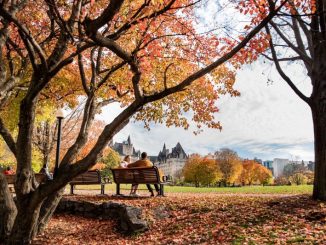

Be the first to comment